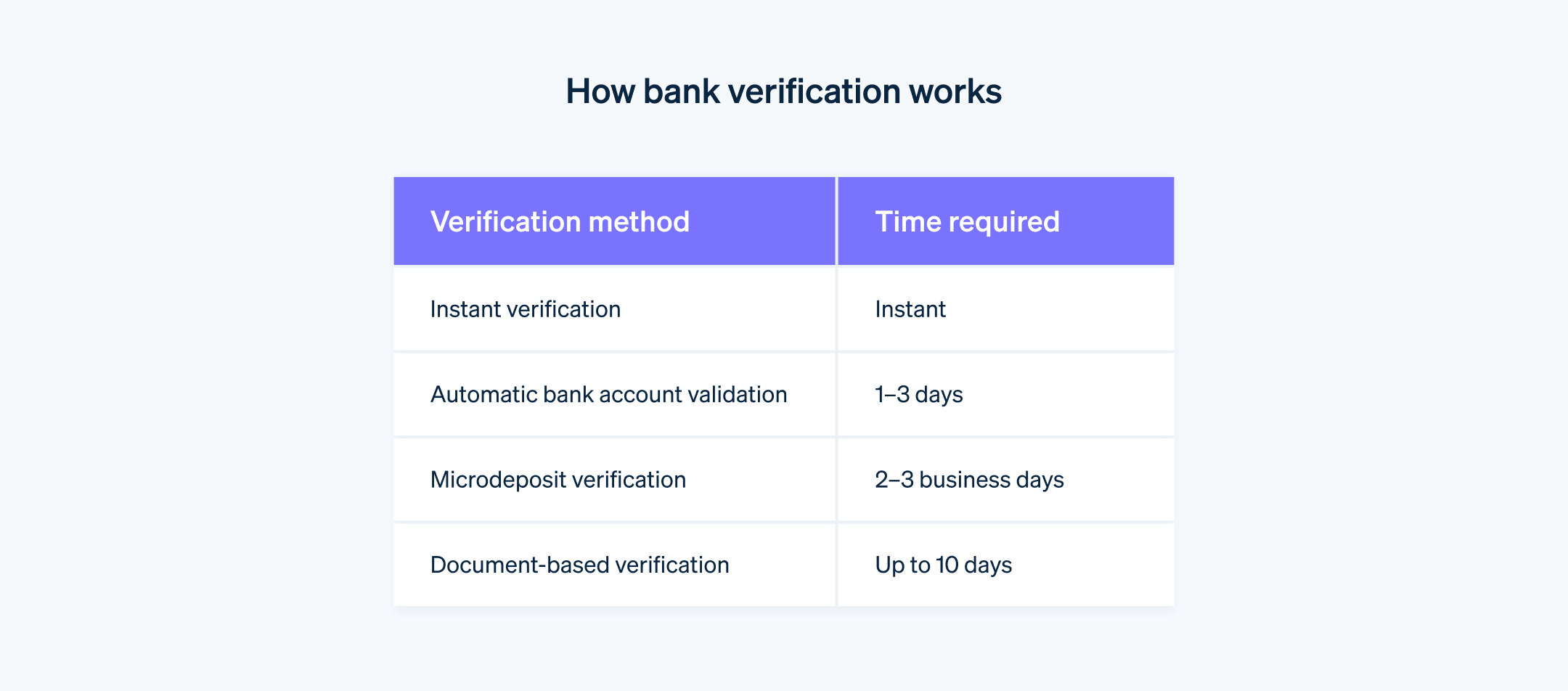最近,支付欺诈变得更加普遍和复杂。根据联邦贸易委员会 (FTC) 的一份报告,2022 年有 240 万份欺诈报告,损失总额约为 88 亿美元。数字技术的进步使更多类型的企业上线,扩大了金融交易的规模和种类。
随着金融交易从纸质方式转向数字平台,数字交易的复杂性也在不断增加,这就要求制定强有力的安全协议。例如,业务运营的全球化意味着越来越多的公司参与跨境交易(由于监管环境和金融体系不同,这增加了复杂性和风险)。
由于这些变化,企业需要实施更全面的欺诈预防和安全机制。与此同时,客户现在希望金融交易即时无误。要满足这些期望,就必须实施周到、环环相扣的支付解决方案,以实现快速、准确、安全的交易。其中一个解决方案是银行账户验证,这是金融安全协议中日益重要的一部分。
以下是您需要了解的有关银行账户验证的内容、工作原理以及对企业和实现现代支付的金融环境的影响。
目录
- 什么是银行账户验证?
- 银行账户验证的用途?
- 银行账户验证如何进行?
- 为什么银行账户验证很重要?
什么是银行账户验证?
银行账户验证是确认银行账户有效性的过程。这样做有多种原因,包括检查以确保账户处于活动状态、确认账户属于声称拥有所有权的人,以及核实是否有足够的资金用于直接存款或自动付款等交易。银行账户验证通常用于网上银行支付,以降低欺诈或错误的风险。
银行账户验证的用途?
银行账户验证验证特定银行账户的所有权和有效性。它是在线交易 — 特别是电子资金转账和自动清算所 (ACH) 支付 — 以及其他各种金融活动的先决条件。目的是确认关键细节,如账户持有人姓名、账号和账户类型(即支票或储蓄)。它有助于避免错误、减少欺诈并保护电子交易的准确性。
银行账户验证如何进行?
有多种验证方法可供选择。这些方法可能包括根据国家或银行机构协议检查账号结构的算法、验证账户状态的直接小额存款或确认客户身份的多因素验证技术。
无论采用何种验证方法,其主要目的是评估账户的合法性,并降低财务失误或潜在欺诈活动的风险。以下是一些常见的验证方法:

即时验证
此方法使用应用程序编程接口 (API)技术,允许客户通过第三方登录他们的网上银行,如 Stripe Financial Connections。
OAuth(开放授权)是最快、最安全的即时验证方式。OAuth 连接采用基于令牌的身份验证,使客户可以直接登录其网上银行账户,而无需共享用户名和密码。令牌用于保护敏感数据,将其替换为令牌,供企业用于验证账户凭证。该界面可立即提供账户详细信息,便于快速验证。
在以下设置中使用即时验证是很常见的:
- 在线市场:为了加快入驻速度,客户可以快速链接银行账户进行支付或存款。
- 电子商务和订阅:企业可以立即验证客户账户,并开始收取一次性或定期付款。
- 个人财务应用程序:这些应用程序根据交易历史提供预算建议。
- 投资平台:这些平台通常需要详细的财务记录才能运行。
自动银行账户验证
通过自动银行账户验证 (ABAV),客户手动输入银行账户信息,然后由第三方根据数据库验证账户和路由号码,以确保账户合法。这种类型的验证通常出现在以下情况下:
- 线下支付:通过电话或邮件接受订单的商家
- 企业间支付:进行需要人工签约和付款的大额交易的企业
小额存款验证
小额存款验证涉及向被审查账户发送小额转账。收到转账后,账户持有人必须核实对账单描述中的代码或准确金额。虽然被认为是可靠的,但这是一个较慢的过程,可能需要两到三个工作日。这种类型的验证经常出现在涉及传统金融机构的情况下。鉴于这种方法的悠久使用历史,传统银行和信用合作社(对于这些机构来说,缓慢周转更容易被接受)普遍使用这种方法。
基于文档的验证
通过基于文件的验证,账户持有人提供纸质或电子文件,如作废支票或银行对账单,以证实其账户状态和所有权。这通常是一个劳动密集型的选择,可能需要人工监督,这可能会延迟验证过程。此类验证可能适合的一些情况包括:
- 抵押贷款:抵押贷款的风险很高,贷方倾向于使用详尽的文件来核实申请人的财务状况。
- 汽车贷款:与抵押贷款类似,汽车贷款通常需要可靠的文件进行验证。

为什么银行账户验证很重要?
银行账户验证通过支持金融交易的安全性、高效性和合法性,帮助建立对支付处理系统的信任并确保其准确性。以下是银行账户验证如何实现此目的:
建立账户的合法性
确定账户的合法性有助于避免欺诈交易或阻止欺骗行为。对于金融机构和企业来说,准确的账户验证可以防止可能造成高昂代价的财务违规行为。
促进自动化和数字支付
验证可确保账户信息正确无误,从而更顺利地处理直接借记、自动账单支付和网上购物等交易。错误的信息可能会导致交易失败,给客户和企业带来费用并扰乱金融业务。
遵守法规
美国的《银行保密法》和欧洲的 PSD2 等监管框架规定金融机构必须采取某些验证步骤。违规组织可能会被处以巨额罚款,声誉也会受损。验证是满足这些监管要求的内在机制,也是依法经营的必要条件。
提高数据准确性
企业和金融机构收集大量数据,用于分析、决策和改进服务。验证有助于提高这些数据的准确性,使其在未来的业务决策和客户互动中更加可靠。
维护账户持有人关系
验证功能可让账户持有人放心,确认交易合法性的措施已经到位,可防止潜在的金融事故。
Stripe 的防欺诈方法使用集成的机器学习技术和额外的身份验证,帮助将真实客户与欺诈行为者区分开来。
进一步了解如何使用 Stripe 打击欺诈。
本文中的内容仅供一般信息和教育目的,不应被解释为法律或税务建议。Stripe 不保证或担保文章中信息的准确性、完整性、充分性或时效性。您应该寻求在您的司法管辖区获得执业许可的合格律师或会计师的建议,以就您的特定情况提供建议。